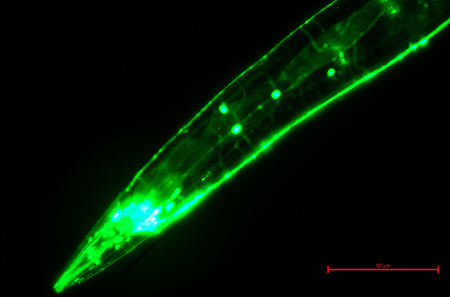A nematode worm shown using fluorescence microscopy. The neuronal cells within the worm can be visualised specifically, as only these cells contain green fluorescent protein
An untreatable and deadly neurodegenerative disease has been modelled and treated in worms by University of Liverpool researchers, suggesting a cure could be found for humans.
The scientists studied adult onset neuronal lipofuscinosis (ANCL) which usually strikes around 1 in 100,000 people in Europe and North America in their 30s and results in death by the mid-40s. There is currently no known treatment for this disease, though it has recently been identified as being caused by mutations in the gene called DNAJC5.
Successfully treated
For the first time scientists, from the University’s Institute of Translational Medicine, have replicated the disease in nematode worms and successfully treated it with a drug called resveratrol.
The worms have a gene called dnj-14 which is their version of the human DNAJC5. Since the worms lifespan is normally only a few weeks, the symptoms of the disease show within a few days and this opens up the possibility of testing thousands of new compounds for treatment within a short period of time – hastening the development of a cure.
Physiologist, Professor Alan Morgan led the study. He said: “ANCL is fortunately rare but it is currently untreatable. This research allows us to quickly test compounds which could be used for treatment. Of the first batch of compounds we used in testing our model, one has already shown encouraging effects.”
Professor Morgan and his colleagues Professor Bob Burgoyne and PhD student, Sudhanva Kashyap now plan to test more compounds with the model and to explore how nematode worms can be used to study more neurodegenerative diseases.
Professor Morgan concluded: “As we face an increasingly ageing population, having treatments for these conditions becomes ever more critical. Studying how these diseases work in a simple organism which is easy and cheap to breed, can speed up the process of developing effective drugs.”
New platform
The paper ‘Caenorhabditis elegans dnj-14, the orthologue of the DNAJC5 gene mutated in adult onset neuronal ceroid lipofuscinosis, provides a new platform for neuroprotective drug screening and identifies a SIR-2.1- independent action of resveratrol,’ was published in the journal Human Molecular Genetics.
The study was funded by grants from the Biotechnology and Biological Sciences Research Council (BBSRC), the Wellcome Trust and the Research into Ageing Fund, a fund set up and managed by Age UK.
Find out more about studying physiology at Liverpool on the University study pages and follow the Institute of Translational Medicine on Twitter.
